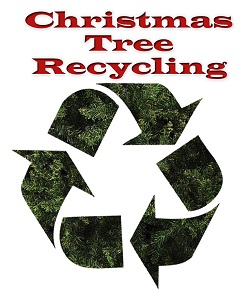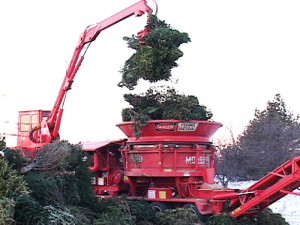How and Where to Recycle Your Christmas Tree After the Holidays
Revised December 2021 (always revised late December / early January)
 If you had a live Christmas tree this year and now wonder what to do with
it: recycle it (how? where?) or if not, dispose of it (how, how much?) then
this page should help you. Many councils and counties have recycling services to put your old Christmas tree to new life as a wildlife sanctuary, chipped for mulch or as a bird feeder. Look below on this page for both general tips and options specific to your local area.
One tip: some areas are now calling a Christmas tree a "Holiday tree".
Ugh!
If you had a live Christmas tree this year and now wonder what to do with
it: recycle it (how? where?) or if not, dispose of it (how, how much?) then
this page should help you. Many councils and counties have recycling services to put your old Christmas tree to new life as a wildlife sanctuary, chipped for mulch or as a bird feeder. Look below on this page for both general tips and options specific to your local area.
One tip: some areas are now calling a Christmas tree a "Holiday tree".
Ugh!
What Are Your Recycling Choices?
After the holidays, don't throw your natural tree away! Here are some tips on what to do with your tree after the holidays. In general, you have these options:
-
 Kerbside pick-up for recycling -
Most areas will collect trees
during their regular pickup schedules on the 2 weeks following
Christmas. For kerbside collection, there are often requirements for size, removing
ornaments, flocking, etc; see
below for where and how to recycle your tree most easily, in your local
area. They'll turn it into mulch, which may be free for you to pick
up, if you want it!
Kerbside pick-up for recycling -
Most areas will collect trees
during their regular pickup schedules on the 2 weeks following
Christmas. For kerbside collection, there are often requirements for size, removing
ornaments, flocking, etc; see
below for where and how to recycle your tree most easily, in your local
area. They'll turn it into mulch, which may be free for you to pick
up, if you want it! - Non-profits that pick up - Call for an appointment to have a non-profit in your area pickup your tree. Some boy scout troops are offering a pickup service for a small donation (often £10).
- Drop it off - Take your tree to a drop off recycling center. Many areas have free drop-off locations throughout the council or county. Usually, you may take up to two trees to any of the following drop-off locations at no charge.
- Green waste pickup - Cut the tree to fit loosely into your green waste container.
- Recycle it yourself - see farther down this page.
Local Options
Unless otherwise noted, all stands, lights, decorations, and tinsel must be removed. Artificial Christmas trees can not be recycled. They must go out with the garbage.
General tips for most haulers:
- Remove all ornaments, tinsel, lights, and other NON-Organic decorative materials. This includes tree stands also.
- Trees are often required to be cut into 4 ft lengths; so you may need to cut your tree in half. In some locales, the trees must be cut small enough pieces to fit inside your green (garden waste) container.
- Flocked trees will often need to be chopped-up and disposed with regular solid waste. Not all areas will take flocked trees. Each area has different requirements, so be sure to check with your hauler's website (see below).
- Trees are usually collected kerbside for two weeks after Christmas, sometimes the whole month of January.
- FREE Drop-off locations are also commonly available
- If you miss the collection period, you can cut-up the tree and place it in your green (garden waste) container for pick-up on the regularly scheduled service day; assuming your area has a garden waste collection program to which you subscribe.
Click on the links below to find your local Christmas tree recycling options.
Specific local information is given below, where available. If no local information is provided, and you wish to add it, please use the feedback form!
England
- Greater London and Surrey
- Berkshire, Buckinghamshire, Oxfordshire
- Northern East Anglia
- Southern East Anglia (Essex, Bedfordshire, Hertfordshire)
- East Midlands
- West Midlands
- Northeast England
- Northwest England (Cheshire, Greater Manchester, Lancashire, Merseyside)
- Hampshire
- Kent
- Sussex (East and West Sussex)
- Cornwall and Devon
- South West England (Dorset, Gloucestershire, Somerset, Wiltshire)
- Yorkshire
Scotland, Wales and Northern Ireland
Other tips and ideas
- Removing the tree: The best way to avoid a mess removing your tree is to place a plastic tree bag (which are available at hardware stores) underneath the stand when you set the tree up! You can hide it with a tree skirt. Then, when the holidays are done, pull the bag up around the tree, stand and all, and carry it outside. Obviously, you will want to remove the stand before recycling the tree. If some needles do scatter inside, it is better to sweep them up; as needles can clog vacuum cleaners.
-
Tree Recycling / Mulching programs are a fast-growing trend in communities throughout the nation. Check below on this page or with your local department of public works for information.
They chip and shred the trees, then make the mulch available for use in
your garden. Your
hauler will notify you of pick-up dates in your area. There are a few
things you must do to make your tree ready for RECYCLING. Here are some
general tips - but be sure to check with your local hauler - these are
just general guidelines! To find your local hauler:
If it is Waste Management Inc (WM), click here to find your Local WM Service Provider's Website - or click here to contact Your Local WM Customer Service Center by Phone - find the 1-800 number of your Local Customer Service Center
If your local hauler is AW / BFI (Allied Waste) - Click here to locate the contact information for your local hauler. - Soil erosion barriers: Some communities use Christmas trees to make effective sand and soil erosion barriers, especially at for lake and river shoreline stabilization and river delta sedimentation management (Louisiana does both).
- Fish feeders: Sunk into private fish ponds trees make excellent refuge, breeding area and feeding area for fish.
- Bird feeders: Place the Christmas tree in the garden or backgarden and use it as a bird feeder and sanctuary. Fresh orange slices or strung popcorn will attract the birds and they can sit in the branches for shelter. (Make sure all decorations, hooks, garland and tinsel strands are removed). Eventually (within a year) the branches will become brittle and you can break the tree apart by hand or chip it in a chipper. See this article from Perdue University for more information.
- Mulch: A Christmas tree is biodegradable; its branches may be removed, chipped, and used as mulch in the garden. If you have a neighbor with a chipper, see if he will chip it for you. Be sure to apply garden lime on the mulc to counter the acidity.
- Paths for Hiking Trails - some counties use the shredded trees as a free, renewable and natural path material that fits both the environment and the needs of hikers!
- Living, rooted trees: Of course, next year, you could get a rooted (ball and burlapped or containerized) tree and then plant it in your garden after Christmas (It's a good idea to pre-dig the hole in the late Fall while the soil is still soft,
then plant the tree into that hole immediately after Christmas.) NOTE: Living trees have a better survival rate in mild climates,
than in a northern area.
- Important: Never burn your Christmas tree in a fireplace or wood stove. Pines, firs and other evergreens have a high content of flammable turpentine oils. Burning the tree may contribute to creosote buildup and risk a chimney fire.
Gift ideas:
iRobot Roomba 960 Robot Vacuum Cleaner
or
Less expensive unbranded Robot Vacuum Cleaner with Mop, 4500Pa Ultra Strong Suction
or
Ninja Foodi MAX Dual Zone Air Fryer
Christmas tree accessories:
Christmas tree decorations
Tree Stand for Up To 8ft/2.5m Tall Cinco Advantage 8
1,000 LED Christmas-Tree Lights, 25 meters
Nearly Natural 3ft Norfolk Island Pine Artificial Tree
or a much less expensive
2 ft Norfolk Island pine
Tree Stand for Up To 8ft/2.5m Tall Cinco Advantage 8
Gift ideas:
iRobot Roomba 960 Robot Vacuum Cleaner
or
Less expensive unbranded Robot Vacuum Cleaner with Mop, 4500Pa Ultra Strong Suction
or
Ninja Foodi MAX Dual Zone Air Fryer
Christmas tree accessories:
Christmas tree decorations
Tree Stand for Up To 8ft/2.5m Tall Cinco Advantage 8
Star-Max F-H-S Start 1 Christmas Tree Stand for trees upto 2m
1,000 LED Christmas-Tree Lights, 25 meters
Christmas tree decorations
1,000 LED Christmas-Tree Lights, 25 meters
Find Other types of farms:
- Farmshops, farmers markets and roadside stands
- Pick Your Own Farms
- Christmas Tree Farms
- Local Honey Sources
- Local Meat, Milk and Eggs
- U.S. Road trips and camping